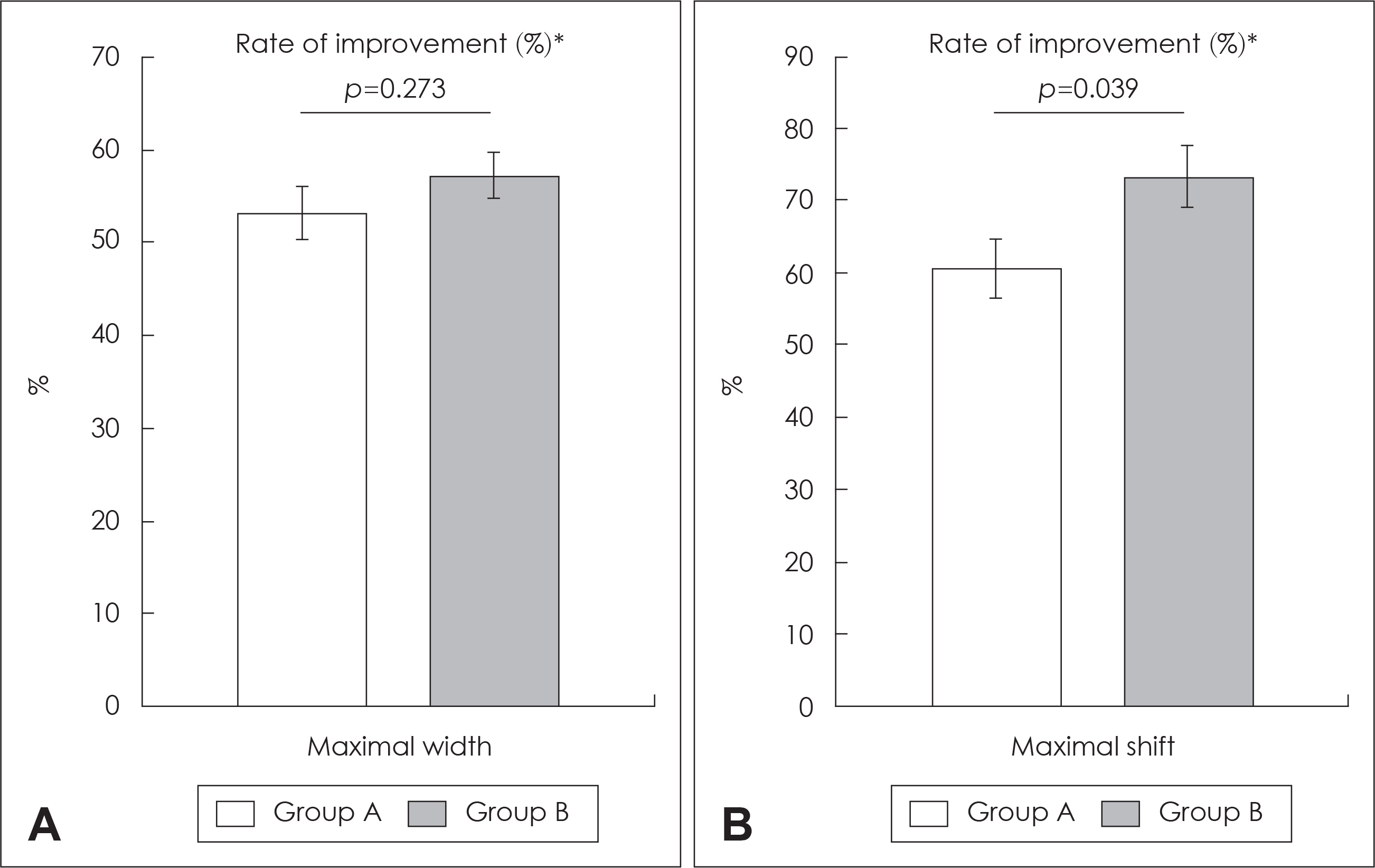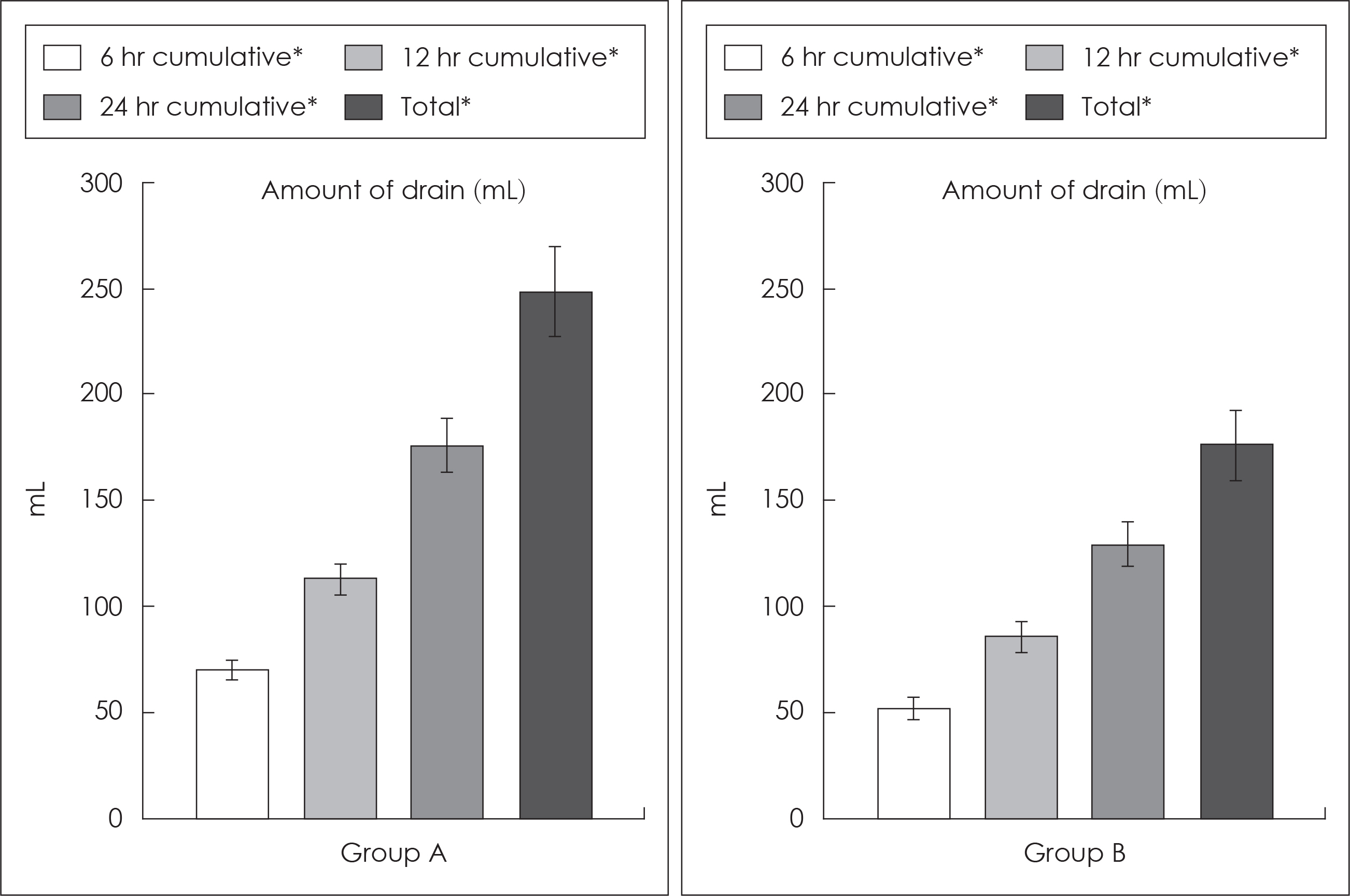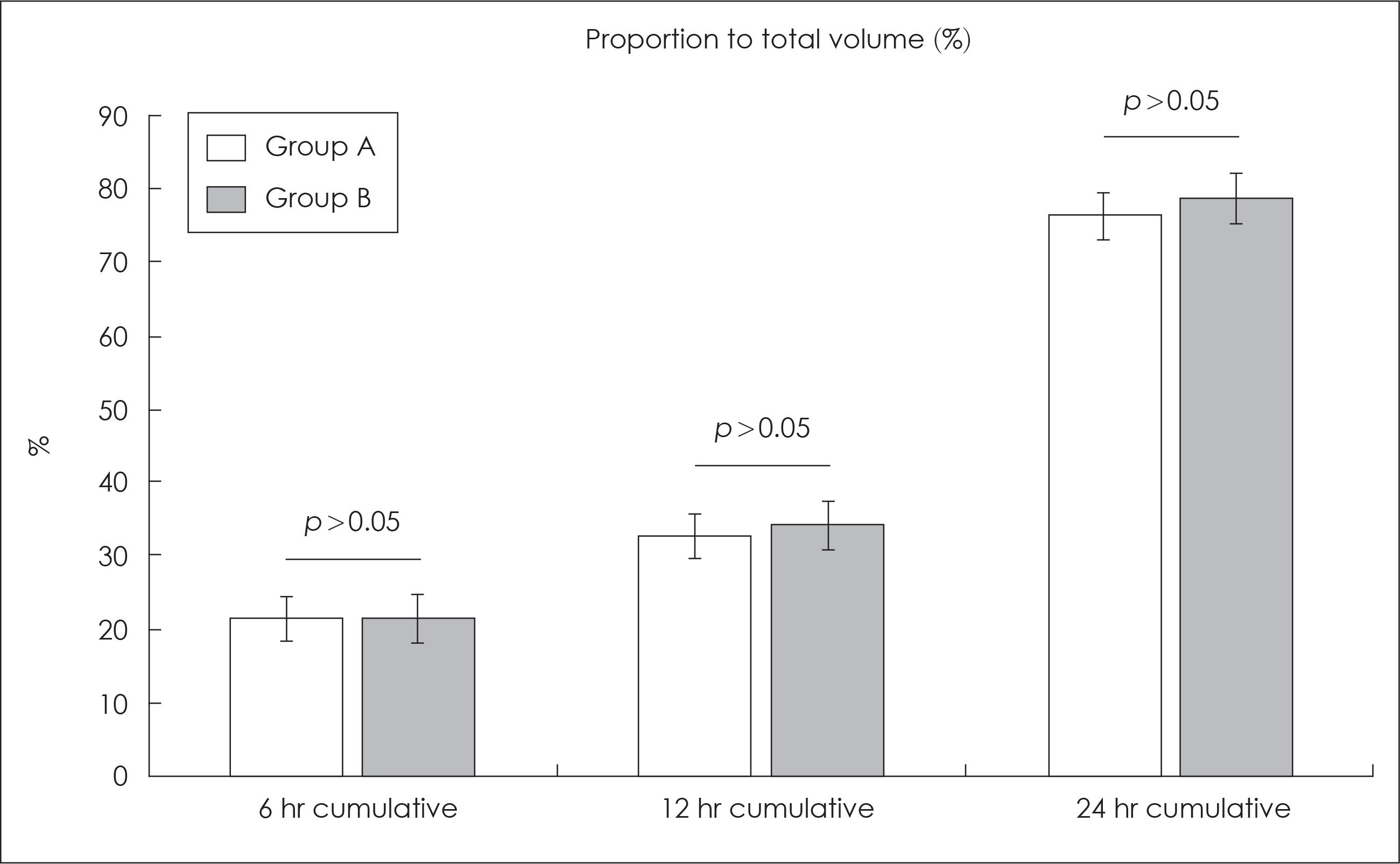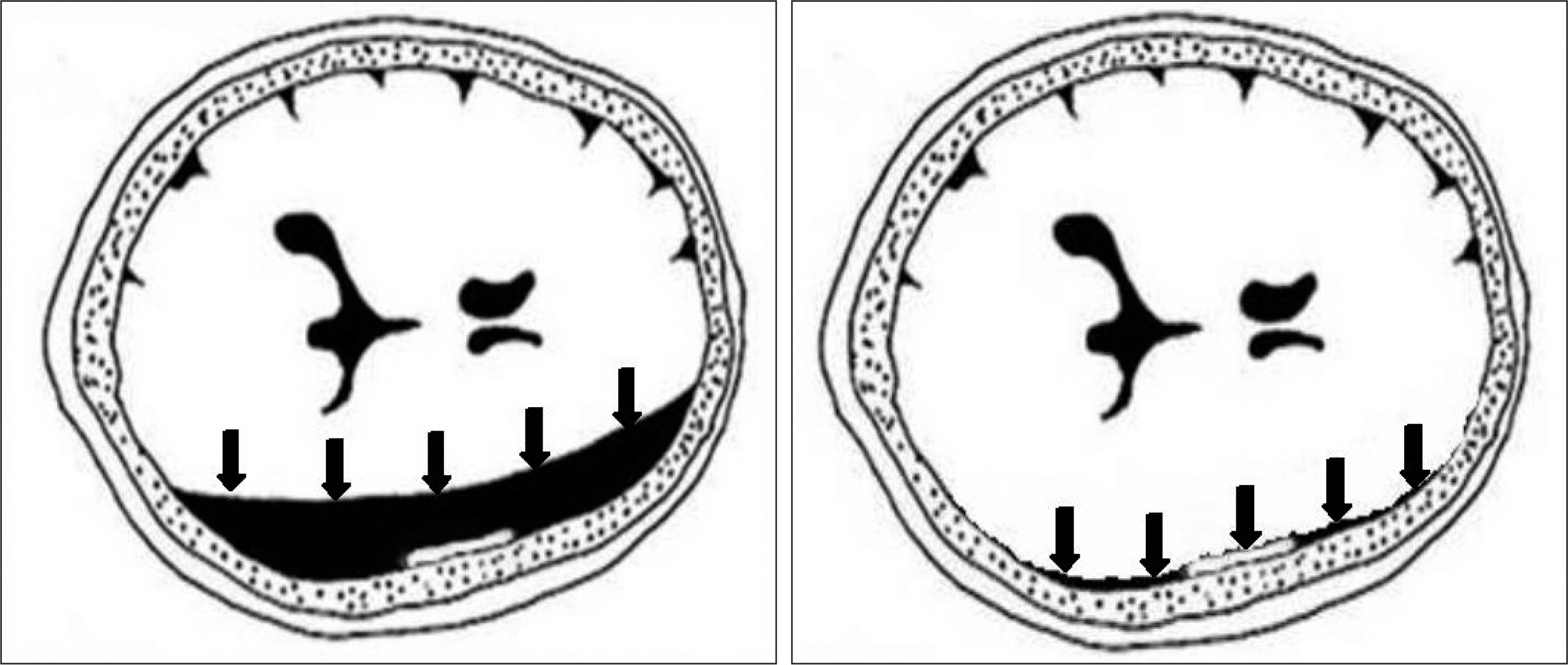Korean J Neurotrauma.
2012 Oct;8(2):134-138. 10.13004/kjnt.2012.8.2.134.
The Influence of Postoperative Lesion-Down Head Position on the Recurrence Rate in Chronic Subdural Hematoma after Burr-Hole Surgery
- Affiliations
-
- 1Department of Neurosurgery, School of Medicine, Chungnam National University, Daejeon, Korea. swchoi@cnu.ac.kr
- KMID: 1427727
- DOI: http://doi.org/10.13004/kjnt.2012.8.2.134
Abstract
OBJECTIVE
Chronic subdural hematoma is a common disorder observed in neurosurgical care and the recurrence rate is relatively high. In this report, we evaluated the relationship between the recurrence rate of chronic subdural hematoma and the postoperative head position of the patient.
METHODS
We conducted a retrospective study of 72 patients with unilateral chronic subdural hematoma treated by burr hole surgery with closed system drainage from October 2009 to May 2011. In group A, there was no restriction in head position for days keeping the catheter. In group B, the patients were placed with the lesion side of the head downward after the operation. We analyzed the recurrence rate, amount of postoperative drainage and changes in computed tomography finding of group A and B.
RESULTS
Group A and group B consisted of 36 cases, respectively. The mean amount of total postoperative drainage was 248.8+/-127.2 mL in group A and 176.3+/-98.9 mL in group B (p=0.01). The improvement rates of midline shifting before and after surgery showed 60.5+/-25.6% in group A and 73.4+/-26.3% in group B (p=0.039). The total recurrence rate in group A was 11.1% and 5.6% in group B.
CONCLUSION
By facing the lesion downward after surgical treatment, chronic subdural hematoma is thought to help reexpand the brain and to prohibit cerebrospinal fluid from flowing into subdural space and to decrease the recurrence rate better than having a free position.
Keyword
MeSH Terms
Figure
Reference
-
1). Abouzari M., Rashidi A., Rezaii J., Esfandiari K., Asadollahi M., Ale-ali H, et al. The role of postoperative patient posture in the recurrence of traumatic chronic subdural hematoma after burr-hole surgery. Neurosurgery. 61:794–797. discussion 797. 2007.
Article2). Apfelbaum RI., Guthkelch AN., Shulman K. Experimental production of subdural hematomas. J Neurosurg. 40:336–346. 1974.
Article3). Benzel EC., Bridges RM Jr., Hadden TA., Orrison WW. The single burr hole technique for the evacuation of non-acute subdural he-matomas. J Trauma. 36:190–194. 1994.
Article4). Camel M., Grubb RL Jr. Treatment of chronic subdural hematoma by twist-drill craniotomy with continuous catheter drainage. J Neurosurg. 65:183–187. 1986.5). Choi CH., Moon BG., Kang HI., Lee SJ., Kim JS. Factors affecting the reaccumulation of chronic subdural hematoma after burr-hole trephination and closed-system drainage. J Korean Neurosurg Soc. 35:192–198. 2004.6). Chung YS., Kim HJ., Han DH. Surgical Management of chronic subdural hematoma: the outcome and factors relating to the brain expansion. J Korean Neurosurg Soc. 22:1239–1249. 1993.7). Hamilton MG., Frizzell JB., Tranmer BI. Chronic subdural hematoma: the role for craniotomy reevaluated. Neurosurgery. 33:67–72. 1993.8). Ishfaq A., Ahmed I., Bhatti SH. Effect of head positioning on outcome after burr hole craniostomy for chronic subdural haematoma. J Coll Physicians Surg Pak. 19:492–495. 2009.9). Markwalder TM. Chronic subdural hematomas: a review. J Neurosurg. 54:637–645. 1981.
Article10). Markwalder TM., Reulen HJ. Influence of neomembranous organisation, cortical expansion and subdural pressure on the postoperative course of chronic subdural haematoma—an analysis of 201 cases. Acta Neurochir (Wien). 79:100–106. 1986.
Article11). Markwalder TM., Steinsiepe KF., Rohner M., Reichenbach W., Markwalder H. The course of chronic subdural hematomas after burr-hole craniostomy and closed-system drainage. J Neurosurg. 55:390–396. 1981.
Article12). Miele VJ., Sadrolhefazi A., Bailes JE. Influence of head position on the effectiveness of twist drill craniostomy for chronic subdural hematoma. Surg Neurol. 63:420–423. discussion 423. 2005.
Article13). Mohamed EE. Chronic subdural haematoma treated by craniotomy, durectomy, outer membranectomy and subgaleal suction drainage. Personal experience in 39 patients. Br J Neurosurg. 17:244–247. 2003.
Article14). Mondorf Y., Abu-Owaimer M., Gaab MR., Oertel JM. Chronic subdural hematoma—craniotomy versus burr hole trepanation. Br J Neurosurg. 23:612–616. 2009.
Article15). Nakajima H., Yasui T., Nishikawa M., Kishi H., Kan M. The role of postoperative patient posture in the recurrence of chronic subdural hematoma: a prospective randomized trial. Surg Neurol. 58:385–387. discussion 387. 2002.
Article16). Obana WG., Pitts LH. Management of head injury. Extracerebral lesions. Neurosurg Clin N Am. 2:351–372. 1991.17). Okada Y., Akai T., Okamoto K., Iida T., Takata H., Iizuka H. A comparative study of the treatment of chronic subdural hematoma—burr hole drainage versus burr hole irrigation. Surg Neurol. 57:405–409. discussion 410. 2002.
Article18). Probst C. Peritoneal drainage of chronic subdural hematomas in older patients. J Neurosurg. 68:908–911. 1988.
Article19). Ram Z., Hadani M., Sahar A., Spiegelmann R. Continuous irrigation-drainage of the subdural space for the treatment of chronic subdural haematoma. A prospective clinical trial. Acta Neurochir (Wien). 120:40–43. 1993.
Article20). Robinson RG. Chronic subdural hematoma: surgical management in 133 patients. J Neurosurg. 61:263–268. 1984.
Article21). Rocchi G., Caroli E., Salvati M., Delfini R. Membranectomy in organized chronic subdural hematomas: indications and technical notes. Surg Neurol. 67:374–380. discussion 380. 2007.
Article22). Sharp AA. Diagnosis and management of disseminated intravascular coagulation. Br Med Bull. 33:265–272. 1977.
Article23). Yu GJ., Han CZ., Zhang M., Zhuang HT., Jiang YG. Prolonged drainage reduces the recurrence of chronic subdural hematoma. Br J Neurosurg. 23:606–611. 2009.
Article
- Full Text Links
- Actions
-
Cited
- CITED
-
- Close
- Share
- Similar articles
-
- Burr Hole Drainage versus Small Craniotomy of Chronic Subdural Hematomas
- Factors Affecting the Reaccumulation of Chronic Subdural Hematoma after Burr-hole Trephination and Closed-system Drainage
- Factor Affecting Recurrence of Chronic Subdural Hematoma after Burr-Hole Drainage
- Cerebellar Hemorrhage after Burr Hole Drainage of Supratentorial Chronic Subdural Hematoma
- The Technical Factors that Influence Recurrence of Chronic Subdural Hematoma: A Review of 140 Consecutive Surgical Cases





